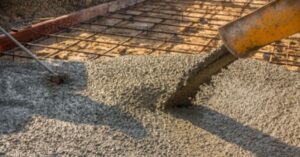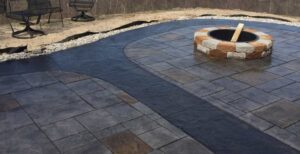Residential Concrete Contractors Dallas TX is an excellent material for patios because it can withstand harsh weather conditions. It is also durable and easy to clean. It also resists mold and other harmful substances.
Homeowners can choose from many customization options to make their patios feel like the perfect outdoor space. These include brushed, stenciled, engraved, and pebbled finishes that mimic more expensive patio materials.

Concrete is an affordable choice for a backyard patio, particularly when it is poured in-house by a professional. However, installation costs can increase if the patio requires footings and excavation. This is a good time to consult multiple contractors for quotes and compare reviews. It is also important to determine if you will need permits or site preparation.
A professional contractor can install a concrete patio quickly and affordably, typically in about four days. Concrete patios are also environmentally friendly. They don’t require lumber, which helps preserve trees and reduce chemical waste from wood staining and finishes. In addition, porous concrete can help reduce stormwater runoff, reducing pollution and preventing erosion.
The cost of a concrete patio depends on size, style, and finish. A plain gray concrete slab is the least expensive option, while stamped concrete that mimics the look of brick or stone slabs is more costly. Other finish options include etching, stenciling, or engraving the concrete to add pattern and color.
In general, square and rectangular patios are less expensive than unique shapes because they are easier to construct. The thickness of the concrete is another factor that affects cost. Patios that support heavy items like a hot tub or outdoor kitchen must be at least 4 inches thick, so that they will require more material than a standard patio.
With its solid surface, a concrete patio is more durable than a paving stone patio and can withstand a greater amount of pressure. It is also easier to maintain than a paving stone patio because there are no spaces between individual pavers for grass or weeds to grow.
A well-maintained concrete patio can last for decades. It is easy to clean and resists mold, mildew, and stains. It also doesn’t crack, chip, or splinter as wood does. It can even be repaired more easily than other paving materials. A concrete patio is an excellent investment that will add to the resale value of your home. It is also a great way to make the most of your backyard and spend more time outdoors.
Concrete patios are more durable than pavers and accommodate heavy furniture, foot traffic, and pets. They also resist cracking and fading better than other materials. In addition, they are easy to maintain and can last 30 years or more with proper care and maintenance.
Homeowners can customize the look of their concrete patios with different stains, textures, and finishes to match the landscape and architecture of their homes. They can choose from various patterns and even mimic the look of other popular patio materials such as brick or natural stone. Depending on the style they want, homeowners can choose from several finishing techniques, such as broom or trowel finishing.
Like any other material, concrete has its pros and cons when it comes to durability. It is affordable and relatively simple to install, but it can be prone to cracking and needs regular maintenance. However, if properly reinforced and poured, concrete is one of the most durable patio materials.
While concrete can withstand heavy patio furniture, there are better choices for areas that experience a lot of thawing and refreezing during the winter. In these areas, it is not whether concrete will crack but when. Cracks in a concrete patio can be costly and difficult to repair. It can also be impossible to disguise the repairs because they will be visible completely.
A reputable contractor will use concrete reinforcing fibers to make the concrete more durable and prevent cracking. This is especially important if the patio will be subject to heavy loads, such as furniture or a hot tub. They will also put a vapor barrier underneath the concrete to protect it from moisture that can lead to cracking.
Homeowners should consider hiring a professional to install their concrete patio. A professional will have all the tools to do a high-quality job quickly and efficiently. They will also know how to properly prepare the area for the patio, which will save time and money in the long run. In addition, a professional will learn how to handle any challenges that may arise during the project.
Concrete patios offer a great deal of design flexibility to complement your home and landscape. They can be stamped, engraved, or stenciled to look like pavers at a fraction of the cost. In addition, they are durable and can withstand the elements. The versatility of this material allows you to create a unique outdoor living space and boost your property value.
To give your concrete patio a custom look, try stamping it with a pattern. This process involves imprinting the concrete while it is still wet, allowing you to achieve the appearance of a wide range of materials at a fraction of the price. Concrete can be stamped with designs that resemble stone, brick, tile, and even wood grain. Using a color dye or acid stain, you can also add subtle accents to your patio.
If you want to bring more color to a grey concrete patio, try adding accents with the help of your furniture or other decorations. For example, a large outdoor rug can break up the grey and add color to your backyard. This can make your patio feel cozier and more comfortable.
You can also use concrete to build your patio around water or other features. You can even add a fire pit to your patio, making it a more inviting space for relaxing and entertaining. If you have the budget, you can incorporate a pool into your patio and connect it with your house. This will create a seamless transition from indoor to outdoor living spaces.
Concrete can be molded into any shape, which is useful for creating unique patio shapes that aren’t feasible with pavers or other materials. This versatility makes it a great choice for patios that need to match the shape of your yard or accommodate a curve in the driveway.
A poured-in-place concrete patio is also more adaptable than a precast slab, which means it can be built to fit any space in your yard. This is especially helpful when building a patio on a sloped property.
With the right tools and technique, you can make your concrete patio stand out from the rest of your yard. The right concrete patio will complement your home and landscaping and provide a place to relax and entertain.
Concrete is a great material for patios because it doesn’t crack like pavers or stone can. However, it requires some daily maintenance to keep it looking its best. For instance, you can sweep and hose the concrete to remove dust and debris. You can also clean it with a degreaser made for concrete or a solution of bleach and water. Be sure to wear long pants, closed shoes, and gloves while cleaning, and always follow the instructions and warnings on the product label.
Consider applying a sealer to your concrete patio to prevent corrosion. Most home supply stores sell a variety of sealers, and you can find one that matches your existing concrete color. Sealers are easy to apply and help preserve the look of your patio for many years.
Another benefit of concrete is that it’s a solid surface less prone to weed growth and grass sprouting than pavers or natural stones. This makes it easier to maintain and can reduce tripping hazards. In addition, concrete can withstand a wide range of climate conditions, making it a good choice for many locations.
A concrete patio can be easily damaged by tree roots, which penetrate and lift the concrete slabs. This can be a costly and time-consuming fix. It is important to treat the roots as soon as you notice them. This will prevent them from spreading and damaging the entire patio.
Repairing a cracked concrete patio can be frustrating and expensive. Some cracks are difficult to hide, and matching decorative concrete after repairs can be challenging. To prevent future cracks, you can reinforce the concrete with rebar or wire mesh. Hardware and home improvement stores typically carry concrete crack repair kits that contain the concrete mixture and tools you need to complete the task.
If you’re considering installing a concrete patio, talk to a professional contractor about the best materials and options for your project. A professional can give you detailed information about the benefits and costs of each option and help you choose the best one for your budget and lifestyle.

